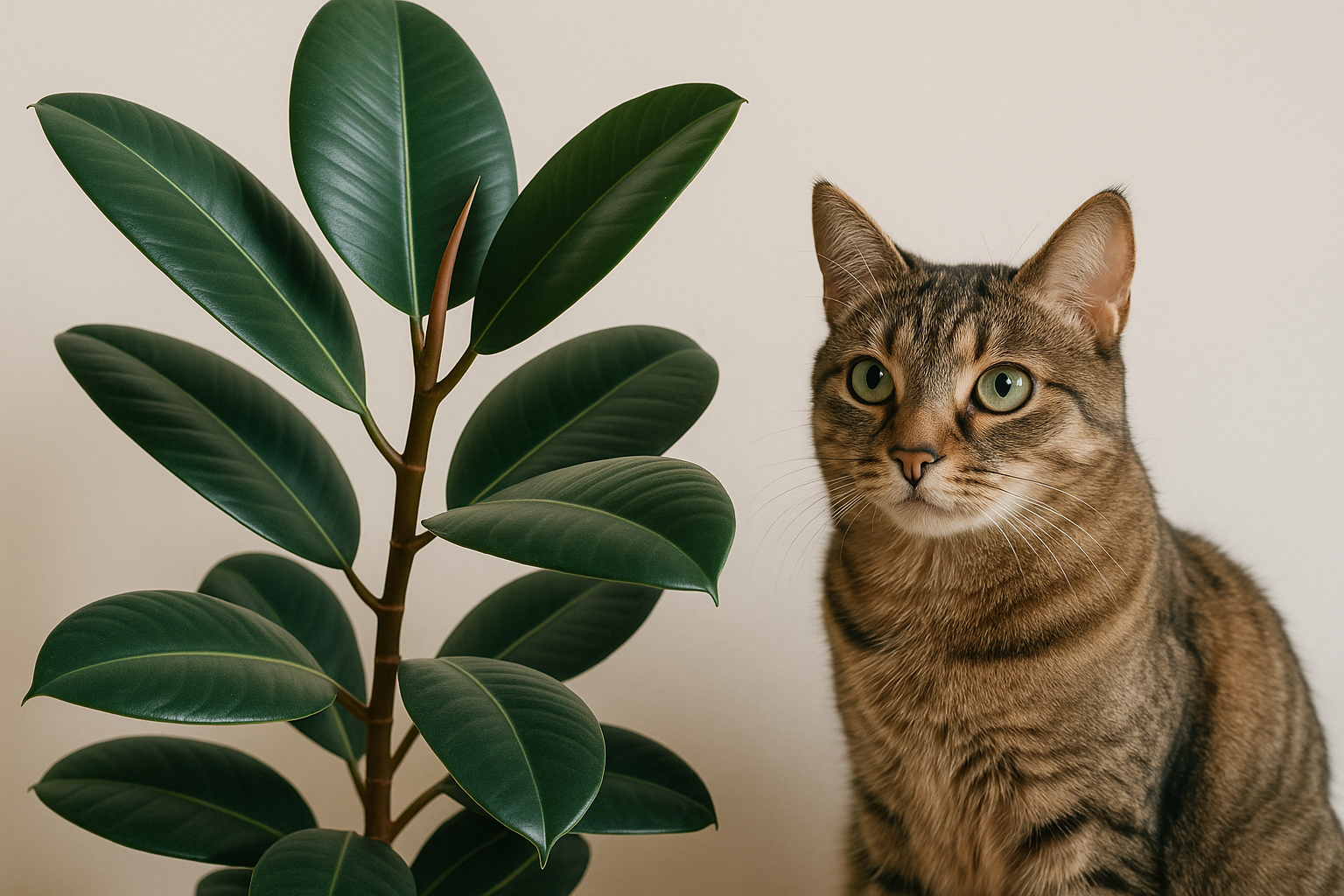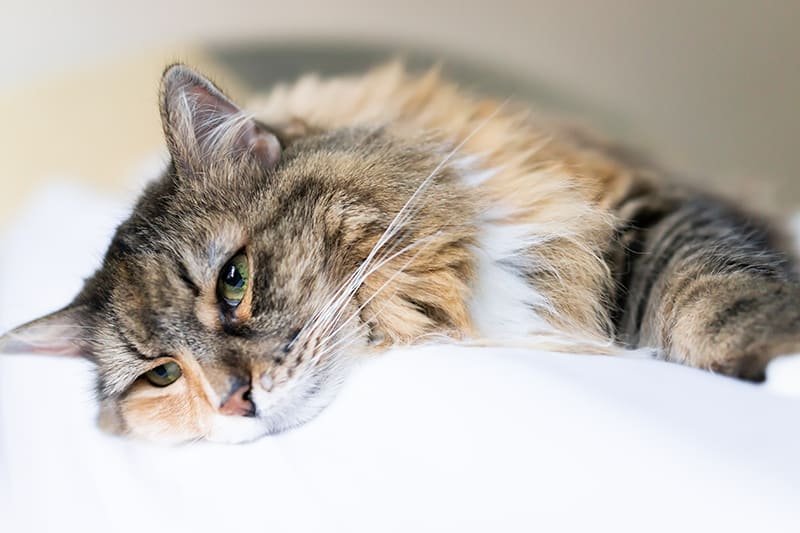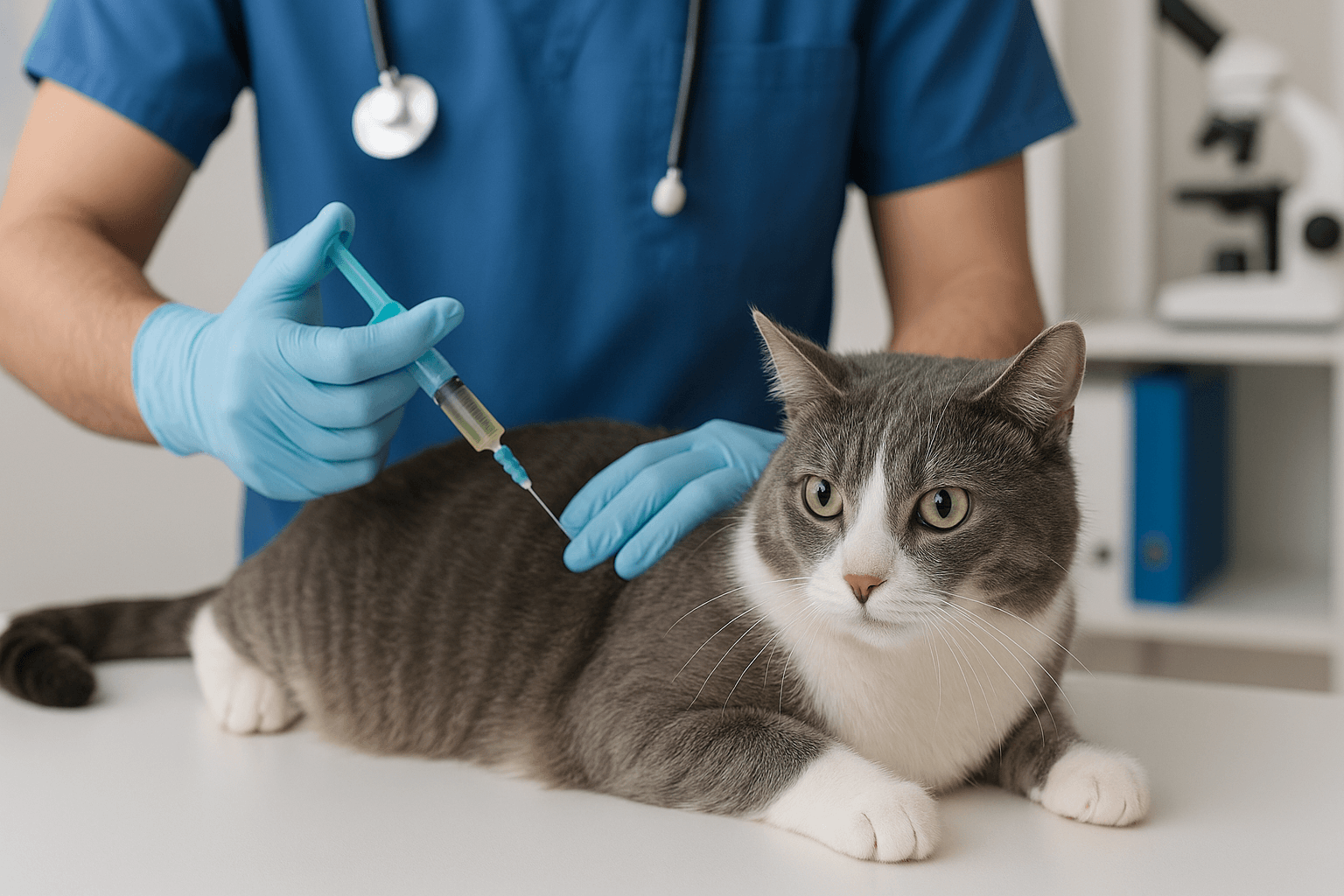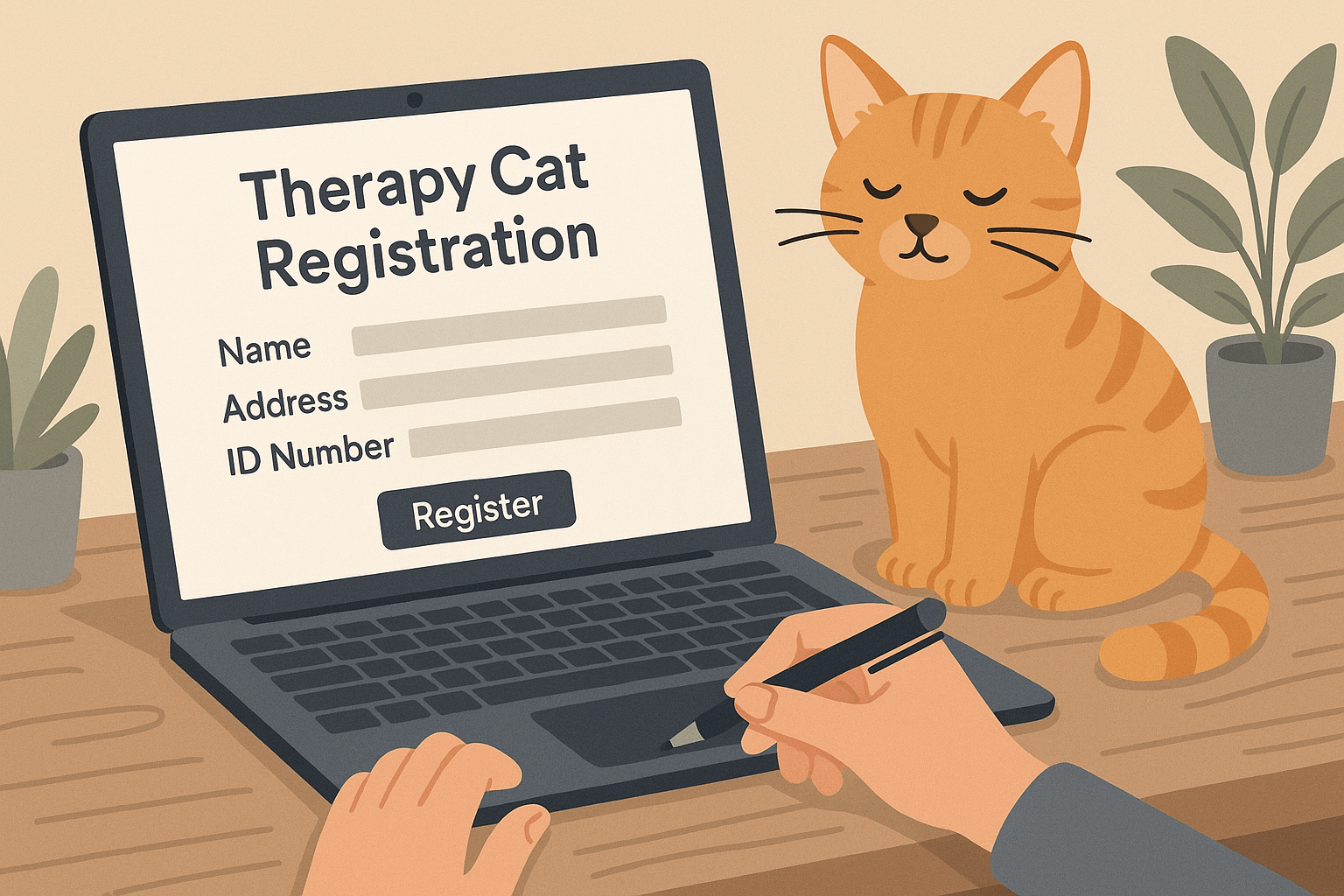Is the Rubber Tree Cat Safe? What You Need to Know
The rubber tree (Ficus elastica) is a popular indoor plant, admired for its glossy leaves and air-purifying qualities. However, if you share your home with a curious feline, you may wonder whether this plant is safe for your cat. While rubber trees are non-toxic, they can still cause mild irritation if ingested or chewed. Understanding the risks and taking preventive measures ensures both your plant and your pet remain healthy. In this blog post, we’ll explore everything you need to know about keeping a rubber tree in a cat-friendly home, including tips for safety and alternative plant options.
Understanding the Risks of Rubber Trees for Cats
While rubber trees are not considered highly toxic to cats, they do pose some risks if ingested. Being aware of these potential issues helps you take proactive steps to protect your furry friend.
Mild Irritation from Sap:
The sap of the rubber tree contains compounds that can irritate your cat’s mouth, throat, or stomach if chewed.Gastrointestinal Upset:
Ingesting parts of the plant may lead to symptoms like vomiting, drooling, or diarrhea in sensitive cats.Skin Irritation:
Contact with the sap can sometimes cause mild skin irritation or itching in cats with sensitive skin.Choking Hazard:
Small pieces of leaves or stems can pose a choking risk if swallowed by an overly curious cat.Behavioral Concerns:
Cats who frequently chew on plants may develop unhealthy habits, which could indicate boredom or dietary deficiencies.
By understanding these risks, you can better assess whether a rubber tree is suitable for your home and how to mitigate potential dangers.
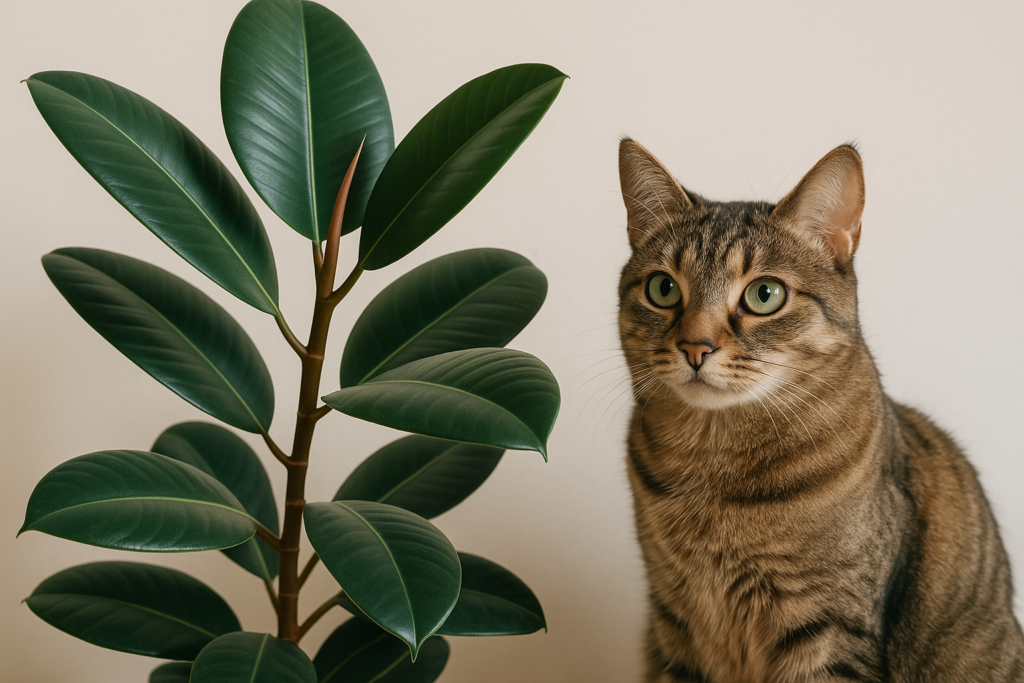
How to Safely Coexist with a Rubber Tree and Cats
If you decide to keep a rubber tree in your home, there are several ways to ensure it coexists peacefully with your cat. These strategies focus on prevention, training, and supervision.
Place the Plant Out of Reach:
Position the rubber tree on a high shelf, hanging planter, or other elevated surface where your cat cannot access it.Use Deterrents:
Apply pet-safe deterrent sprays or place citrus peels near the plant, as cats dislike the scent of citrus.Create Physical Barriers:
Use playpens, plant stands with protective covers, or room dividers to block access to the plant.Provide Cat-Friendly Alternatives:
Offer cat grass or catnip plants as safe chewing options to redirect your cat’s attention away from the rubber tree.Supervise Interactions:
Monitor your cat closely when they’re near the plant to prevent nibbling or destructive behavior.
With these precautions in place, you can enjoy the beauty of a rubber tree while keeping your cat safe and happy.
Check this guide 👉Is Gladiolus Cat Safe? Best 7 Expert Tips!
Check this guide 👉Is the Corn Plant Cat Safe? Best 7 Health Tips!
Check this guide 👉Are Carnations Cat Safe? Best 7 Expert Tips!
Tips for Protecting Your Cat | Signs of Plant Ingestion to Watch For |
|---|---|
Place the rubber tree out of reach | Excessive drooling or foaming at the mouth |
Use pet-safe deterrent sprays | Vomiting or diarrhea |
Provide cat-friendly plants as alternatives | Pawing at the mouth or face |
Supervise interactions with the plant | Loss of appetite or lethargy |
Train your cat to avoid the plant | Redness or swelling around the mouth |
Alternative Plants That Are Safe for Cats
If you’re concerned about the risks associated with rubber trees, consider adding cat-safe plants to your home instead. These options are beautiful, pet-friendly, and easy to care for.
Spider Plant (Chlorophytum comosum):
Known for its air-purifying abilities, the spider plant is non-toxic and thrives in various lighting conditions.Boston Fern (Nephrolepis exaltata):
This lush, fern-like plant adds elegance to any space and poses no harm to curious cats.Areca Palm (Dypsis lutescens):
A low-maintenance option, the areca palm is safe for pets and improves indoor air quality.Calathea (Calathea spp.):
With its striking patterns and vibrant colors, calathea is a visually appealing choice that’s also non-toxic.Herbs Like Basil or Mint:
Growing herbs indoors provides a dual benefit—they’re safe for cats and useful for cooking.
Switching to cat-safe plants ensures your home remains stylish and secure for your feline companion.
Training Your Cat to Avoid the Rubber Tree
Teaching your cat to stay away from the rubber tree requires patience and consistency. These training techniques help redirect their behavior and protect the plant.
Positive Reinforcement:
Reward your cat with treats or praise when they ignore the plant, reinforcing desirable behavior.Redirect Their Attention:
Introduce toys or scratching posts near the plant to divert your cat’s curiosity elsewhere.Use Verbal Cues:
Firmly say “no” or clap your hands when your cat approaches the plant to establish boundaries.Create a Designated Play Area:
Set up a cat-friendly zone with engaging activities to keep them entertained and away from the plant.Be Consistent:
Repeat training sessions daily to reinforce the message and ensure long-term success.
With dedication, you can train your cat to respect your rubber tree and reduce unwanted behaviors.
Signs Your Cat May Have Chewed on a Plant
Identifying whether your cat has interacted with a plant is crucial for addressing potential issues promptly. Look out for these warning signs that indicate your cat may have nibbled on a rubber tree or other foliage.
Excessive Drooling:
Increased saliva production can signal irritation in the mouth caused by plant sap.Vomiting or Diarrhea:
Gastrointestinal upset is a common reaction to ingesting certain plant materials.Pawing at the Mouth:
Cats may paw at their face if they experience discomfort after chewing on a plant.Lethargy or Weakness:
Unusual tiredness could indicate that your cat has consumed something harmful.Redness Around the Mouth:
Skin irritation or redness near the lips and gums may result from exposure to plant sap.
Recognizing these signs allows you to act quickly and seek veterinary advice if necessary.
Benefits of Adding Cat-Safe Plants to Your Home
Incorporating cat-safe plants into your home offers numerous benefits beyond just aesthetic appeal. These plants enhance your living space while promoting harmony between pets and nature.
Improved Air Quality:
Many cat-safe plants, like spider plants and areca palms, naturally purify the air by removing toxins.Stress Relief for Cats:
Having greenery around can provide mental stimulation and enrichment for indoor cats.Peace of Mind for Owners:
Knowing your plants won’t harm your cat reduces anxiety and promotes a worry-free environment.Low Maintenance Options:
Most cat-friendly plants require minimal care, making them ideal for busy households.Enhanced Decor:
Cat-safe plants come in various shapes and sizes, allowing you to customize your decor effortlessly.
Adding these plants creates a balanced and serene atmosphere for both humans and pets.
How to Make Your Home More Cat-Friendly
Designing a cat-friendly home involves more than just choosing safe plants—it’s about creating a space where your feline feels comfortable and secure. Here are some ideas to get started.
Designate Vertical Spaces:
Install shelves or cat trees to give your cat opportunities to climb and explore safely.Offer Hiding Spots:
Provide cozy hideaways like tunnels or enclosed beds to help your cat feel secure.Secure Hazardous Areas:
Block access to unsafe zones, such as balconies or open windows, to prevent accidents.Include Interactive Toys:
Keep your cat entertained with puzzle feeders, laser pointers, or feather wands to satisfy their natural instincts.Maintain Routine Check-Ups:
Regular vet visits ensure your cat stays healthy and catches any issues early.
By focusing on these elements, you can build a loving and safe environment tailored to your cat’s needs.
Frequently Asked Questions About Rubber Trees and Cats
Is the rubber tree toxic to cats?
No, the rubber tree is not highly toxic, but its sap can cause mild irritation if ingested.
What should I do if my cat eats part of the rubber tree?
Monitor your cat for symptoms like vomiting or drooling and contact your vet if concerns arise.
Can I grow cat-safe plants indoors?
Yes, many plants like spider plants, Boston ferns, and herbs are safe for cats and easy to care for.
How can I stop my cat from chewing on plants?
Use deterrents, provide alternatives, and supervise interactions to discourage this behavior.
Are all Ficus plants unsafe for cats?
Some Ficus varieties, like the weeping fig, are more toxic than rubber trees, so research before bringing them home.
Creating a Harmonious Space for Cats and Plants
Having a rubber tree in a cat-friendly home doesn’t have to be a source of stress. By understanding the risks, implementing preventive measures, and exploring alternatives, you can enjoy the beauty of indoor plants without compromising your cat’s well-being. Whether you choose to safeguard your rubber tree or opt for cat-safe varieties, the key is finding a balance that works for everyone. With a little creativity and effort, you can create a harmonious environment where both your plants and your pets thrive.
Is the Rubber Tree Cat Safe? Best 7 Expert Tips! Discover expert advice on keeping rubber plants safely in cat-friendly homes and learn top tips for pet-safe plant care.
Low Red Blood Cell Count in Cats: Best 7 Expert Tips! Discover causes, symptoms, and treatment options for feline anemia. Learn how to support your cat’s health effectively with expert advice.
Understanding Megacolon Treatment: Best 7 Expert Tips! Discover effective strategies to manage feline megacolon, from dietary changes to surgical options, ensuring your cat’s comfort and long-term health.
How to Register a Therapy Cat: Best 7 Expert Tips! Discover essential steps to certify your cat as a therapy animal, prepare them for training, and make a meaningful impact in therapeutic settings.

